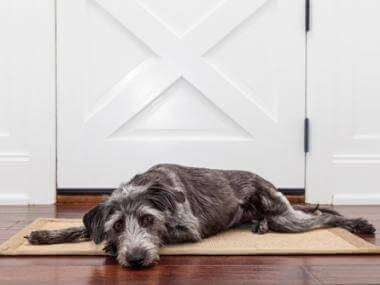Separation Anxiety in Dogs
How to tell separation anxiety from boredom and other problems, and what to do about it.

So, your dog barks nonstop after you leave for work, or not quite nonstop: he pauses long enough to tear up the house and to pee and poop in the middle of the living room floor. “Uh-oh,” you think, once you’re finished tearing out your hair, “Zippy has separation anxiety.”
Maybe, maybe not. This week, learn what separation anxiety is, what it isn’t, how to tell the difference, and what to do.
Buy Now

Separation Anxiety in Dogs
The disorder we call separation anxiety ranges in flavor to mild to a super triple extreme form that some of my colleagues prefer to call separation panic. The common element is that the dog’s behavior looks, as far as we non-telepathic types can see, like an expression of distress at being left alone. And that’s the key–not frustration or boredom, but distress.
How Do You Know If a Dog Has Separation Anxiety?
Here’s a typical scenario. As you get ready for work, Zippy acts more and more restless. He follows you around the house, whining occasionally. Maybe he drools. On a smooth floor, you notice his paws leave sweaty prints. When you pick up your jacket and keys, Zippy slinks off to his bed and lies down, ignoring the smoked beef tendon you left for him there.
And when you get home–whether it’s an hour or five hours later–Zippy goes wild with joy, as if you’d just appeared in a helicopter to lift him off the deck of the Titanic. He grabs the smoked tendon and prances around with it before settling in to chew. Suddenly it’s a prize, though he didn’t touch it all day. Then you notice the smell. Zippy never eliminates inside when you’re home, but while you were gone he left loose stool all over the kitchen floor. Oh, and hire a handyman before the landlord notices the scratch and bite marks around your front windows. Zippy’s gums and paw pads are raw.
Signs of Separation Anxiety in Dogs
Zippy’s behaviors more than meet the criteria for separation anxiety, though not every dog with separation anxiety will act the way Zippy does. Here are some common signs of separation anxiety in dogs:
-
Shows anxiety and stress around your departure: Zippy is restless and whiny; he follows you around, his paws sweat, and he drools. These are clear, specific signs of growing stress. Another dog might demonstrate anxiety by just lying down passively, as if giving up.
-
Ignores food: Zippy also doesn’t touch his chew while he’s alone, though once you’re home he makes it clear that yes, smoked beef tendon is important in Zippy World.
-
Has accidents: Barring illness, Zippy doesn’t eliminate indoors–except when he’s alone, even for just an hour.
-
Tries to escape: Finally, Zippy focused his energy on an exit route. And he took his project seriously: he tried so hard he hurt himself. I’ve made Zippy a silent sufferer, but if he made noise it would probably involve howling or panicked-sounding barks.
Mild Separation Anxiety in Dogs
Zippy’s case is somewhere in the middle of the separation anxiety bell curve. When I adopted her, my Isabella was close to the milder end. Unless her bowels were absolutely empty before we left, we’d find a little pile in the living room when we got home. And we always got the Hello of Crazed Joy. But Iz didn’t have diarrhea and she never chewed or pawed the windows or doors.
Severe Separation Anxiety in Dogs
At the other extreme are dogs who leave oceans of drool in their crates, break teeth and nails against the metal as they struggle to get out, then cut themselves to ribbons shattering a plate glass window to escape.
How to Tell Separation Anxiety from Boredom and Loneliness
By contrast, a destructive, loud dog who’s bored and full of beans will snarf that beef tendon right up and then look for a garbage bin to overturn. Chewing is likely to be directed toward pleasingly fragrant items such as TV remotes and leather shoes–though these sometimes draw the attention of anxious dogs as well. As for a bored and lonely dog, I’d expect a repetitive monotone bark bark bark. It makes you sad while it drives you crazy. If your dog is getting amped about sounds in the hallway or sights on the street, expect flurries of explosive barking, with intervals of silence between.
A dog’s history is revealing, too. When I meet a young, active dog who’s taken up creative redecorating, I always ask about exercise and opportunities to chew. That young, energetic dog had better be getting a solid hour of aerobic exercise first thing in the morning, plus meals given as training rewards and in food-dispensing chewable toys. Otherwise, kiss your sofa and shoes goodbye.
Get Expert Help to Diagnose Separation Anxiety
I made my examples pretty unmistakable–unlike real life. Most of the behaviors associated with separation anxiety can also arise for other reasons, including medical reasons. A dog may bite at doors and windows as part of a frustrated territorial display toward dogs or people passing by. Or she may defecate in your absence because some sound she hears every day at 10:15 scares the living daylights out of her. Or she may suffer not only from separation anxiety but also from allergies that make her bite at her itchy paws. And anxious dogs are still individuals–two dogs with separation anxiety may show their distress in very different ways. So talk to your vet and a skilled behavior consultant. (If you work with a board-certified veterinary behaviorist, these may be the same person.)
What Is the Treatment for Separation Anxiety in Dogs?
Treatment for separation anxiety usually combines meds with behavior modification. What to prescribe is up to your vet.(1) Many clients are uncomfortable with psychoactive medication, but bear in mind that if your dog has separation anxiety, he or she is suffering. And the longer any behavior problem continues, the more entrenched it becomes. Anxiety-related disorders, in particular, just trash a dog’s quality of life. I strongly believe we should throw everything we’ve got at them.
The gold standard in behavior modification involves changing a dog’s associations with your departure activities and gradually accustoming her to longer and longer absences.(2) We usually advise clients to keep greetings and departures low-key–when your dog acts woebegone or excited, it’s best to keep your demeanor matter-of-fact. Dogs read our emotions closely, so it helps to send the message that comings and goings are no big deal.
Separation anxiety is associated with “velcro dogs,” the ones who follow you from room to room and always want to be resting at your feet or pressing their heads against your leg. So some behavior specialists also suggest independence training in various forms–for instance, practicing stays at a distance.
Be Realistic About What You Can Do
When you and your consultant discuss the plan for your dog, try to be realistic about how much time and effort you can put in. Behavior modification for separation anxiety is effective but can be laborious, and one study found that guardians did best with the simplest, least time-intensive plans. (3)
What Causes Separation Anxiety in Dogs?
We don’t quite know what causes separation anxiety. Often, it crops up after a move or a drastic change in schedule. For this reason, dog trainers and behavior specialists often advise clients to include time alone in their puppy or dog’s normal routine. Separation anxiety is commoner among dogs adopted from shelters–but are they anxious because they did time in a shelter, or did their former owners give them up because they had separation anxiety? It’s commoner among dogs owned by single people, but maybe dogs in large households spend less time alone, so their problems are masked. Are male or female dogs more prone to separation anxiety? Depends on which study you read.(4) As I’ve said more than once in these articles, behavior is complicated and hard to understand – beware those who tell you they’ve got The Answer.
My own guess is that separation anxiety has deep evolutionary roots. Wolves, of course, live in stable, family-based groups. Feral dogs generally don’t, but the species didn’t part ways all that long ago. Dogs are obviously sociable and strongly bonded to their human companions. They also depend completely on us, but have no say in our comings and goings. What a surprise it would be if they didn’t get worked up about the situation from time to time!
Send your questions and comments to dogtrainer@ quickanddirtytips.com, or call them in to 206-600-5661, and I may use them in a future article. I Twitter as Dogalini, and you can also find me on Facebook, where I post links to articles and videos and respond to your questions. Thanks for reading!
-
Probably most commonly prescribed is Reconcile (or the generic fluoxetine). But of course medication has to be tailored to the individual animal.
See Simpson, Barbara Sherman, et al. 2007. Effects of Reconcile (fluoxetine) chewable tablets plus behavior management for canine separation anxiety. Veterinary Therapeutics 8:1 (Spring), pp. 18-30. This was a placebo-controlled, double-blinded study with 35 participating veterinary clinics and 242 dogs, a high number for a behavioral study. All that is terrific. However, it was funded by Lilly, the manufacturer of Reconcile. Please note, I am not saying the study is a bad one. It’s hard to get government funding to study medication for animals, and I would rather have a well-done manufacturer-funded study than none at all!
-
The best basic guide for guardians is Patricia McConnell’s pamphlet “I’ll Be Home Soon!” (McConnell Publishing, 2000).
-
Takeuchi, Yukari, Katherine A. Houpt, and Janet M.a Scarlett. 2000. Evaluation of treatments for separation anxiety in dogs. Journal of the American Veterinary Medical Association 217:3 (Aug. 1), 342-45.
-
For the preceding discussion, I’ve drawn mostly on the following sources: G. Landsberg, W. Hunthausen, and L. Ackerman, Handbook of Behavior Problems of the Dog and Cat, 2nd ed. (Saunders, 2003), pp. 258-267; Bradshaw, J.W.S., et al. 2002. Aetiology of separation-related behaviour in domestic dogs. The Veterinary Record 151:2, 43-46; Flannigan, Gerrard, and Nicholas H. Dodman. 2001. Risk factors and behaviors associated with separation anxiety in dogs. Journal of the American Veterinary Medical Association 219:4, pp. 460-466; Horwitz, Debra F., “Separation-Related Problems in Dogs,” in Debra F. Horwitz, Daniel Mills, and Sarah Heath, eds., BSAVA Manual of Canine and Feline Behavioural Medicine (British Small Animal Veterinary Association, 2002), pp. 154-163. There are many other scholarly publications and journal articles on the subject.
Dog Igoring Food image from Shutterstock





